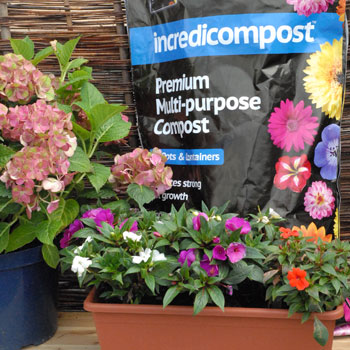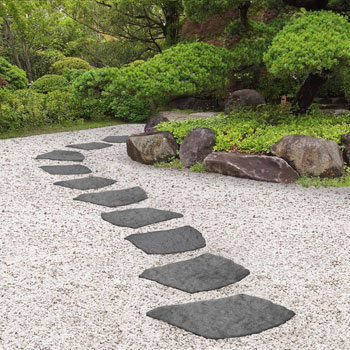Top 10 tips for an eco-friendly garden
Being environmentally friendly in the garden can sometimes feel like an impossible aspiration, but don't be put off - there are plenty of ways to make your garden 'greener'!
It's not all about growing your own, and living off the land. Eco-friendly gardening also includes using sustainable products, minimising waste and encouraging wildlife. You don't need to do it all - just a few small changes can make a big difference.
Better still, eco-gardening needn't cost the earth (no pun intended), in fact, it may actually save you a few pounds!
Read on to discover our top tips for an eco-friendly garden, and discover nature-friendly garden products that can make 'going green' a little bit easier.
1. Go peat free

Over the last decade, it has become far easier to go peat-free, or at least reduce your peat use. Compost manufacturers now offer up a wide range of reduced-peat and peat-free growing medium developed from sustainable materials such as bark, coir (coconut fibre) and green waste.
Many gardeners still prefer to use reduced-peat compost such as incredicompost, finding that the resulting plants are more consistent. For a completely sustainable option, try expandable incredicoir blocks. These ingenious compost blocks take up a fraction of the space of traditional compost, and can be quickly and easily mixed with water and incredibloom fertiliser, to create 10 litres of peat-free compost. Be sure to use the recommended fertiliser when going peat free, as different compost types have different nutrient values.
2. Water wisely

Reducing your mains tap-water use in the garden is simple and will save you a small fortune! Invest in as many water butts as you can fit around your garden to harvest rainwater from your gutters.
Where tap water use is unavoidable, try to use it wisely. Avoid using sprinklers, and opt for a more targeted irrigation system such as a seeper hose in beds and borders, or drip irrigation in patio pots and grow bags. Placing pot saucers beneath patio pots will also help to minimise 'run-off' during dry periods.
Watering plants early in the morning or late in the day will reduce evaporation by the sun, saving you time and effort.
3. Save electricity

Reducing electricity in the garden offers another environmentally friendly way to save you some money. Solar products are far more reliable these days, and there are a massive range of solar garden products available.
Solar lighting is easier to install than traditional electric lights, allowing you to light up even the furthest reaches of your garden. There's something to suit every taste and budget, from elegant string lights to security lighting and novelty flamingos!
Solar water features also make it easier than ever to bring a wildlife friendly water-source to the garden and make a fabulous focal point too.
4. Introduce tougher planting schemes

Choosing the right plant choices for your garden can make it far more sustainable. On dry soils, opt for drought resistant plants that will naturally cope well with these conditions without the need for constant watering.
Plants with silver or grey-green foliage such as Brachyglottis, Santolina and Lavender, and those with furry leaves like Stachys and Verbascum bombyciferum are often good indicators of drought tolerance. Many of these have Mediterranean origins, coping well with a hot climate and well-drained soil.
5. Choose environmentally-friendly controls for pests, diseases and weeds

There are plenty of alternatives to using harmful chemicals in the garden. Common pests such as slugs and snails can be kept as bay using slug traps, copper tape, rock wool pellets or a mulch of sharp grit. A nightly collection with a torch and a bucket will also help to keep their numbers down.
For aphid control, try sprays of diluted soapy water or commercial controls based on natural ingredients like fatty acids. However these may also pose a risk to valuable pollinating insects. If caught early, infestations can usually be reduced by simply squashing them. In the greenhouse, biological controls (introducing aphid predators) can also be highly effective.
Weed control can be reduced by using woven groundcover fabric, weed burners or weed sweepers. Removal by hand is equally effective if tackled regularly.
6. Recycle and reuse

A good compost heap should be the pride of every garden! Don't bin your green waste when it can be turned into fabulous compost that will make a nutrient-rich, water retaining mulch for your beds and borders. Invest in a rotating composter for a quick 8 week turnaround, or a static compost bin for a slower process, and let the magic begin!
Use recycled materials wherever possible. Old sleepers or wooden pallets can be used for constructing raised beds and garden furniture. Recycled tyres make excellent planters, but can also be reformed into stepping stones and border edges adding a great finishing touch to the garden.
For more recycling tips, take a look at this article.
7. Use biodegradable products

Plastic has become a common feature in our gardens, but there are plenty of environmentally friendly alternatives available.
Pot seedlings up into fibre pots or cut down toilet roll tubes instead of plastic pots and trays. They can be planted directly into the ground when the plants are grown without the need to disturb the roots.
Wooden labels offer a more sustainable source than plastic labels and tend to look nicer too. Opt for raffia tie or biodegradable twine to tie plants to supports instead of plastic and wire.
Be creative and you will find there are lots of eco-friendly solutions that will often add quirky character and a bit of fun to the garden. Check out this blog on gardening without plastic for more ideas.
8. Attract wildlife

Gardens provide vital habitats for local wildlife. Encouraging wildlife onto your plot is good for your garden too, bringing in natural predators for those pesky slugs, snails and aphids!
Start by introducing plants for wildlife, growing nectar rich species to feed pollinating insects. You can also provide shelter for them too, by installing insect houses and ladybird and butterfly shelters.
Birds will quickly follow, so it's well worth installing a variety of bird nesting boxes and a bird bath. To keep birds visiting your garden in winter, provide a feeding station, fat balls or multiple bird feeders dotted around the garden with a range of different bird seed to encourage different species.
Garden mammals will appreciate a quiet, rarely visited area of the garden. Install a hedgehog house to make these helpful garden visitors feel welcome.
For more ideas on how to encourage wildlife into your garden, take a look at our in-depth wildlife gardening section.
9. Create a pond

A garden pond is one of the most diverse and valuable of garden habitats that you can provide in your garden. A pond will create an oasis for passing birds and mammals as well as providing habitats for frogs, newts and aquatic insects.
Although it's tempting to stock up with goldfish, they tend to eat tadpoles and insect larvae - your pond will provide a safer habitat without them! Plant up your pond with native species of aquatic plants to encourage the greatest diversity of wildlife.
10. Grow your own

If you have the time, then growing your own fruit and veg is a great way to reduce your impact on the environment. Better still, it's fun, it will save you money, and it's great exercise!
You don't need a huge vegetable plot you can grow strawberries, blueberries, potatoes, salad leaves, herbs, tomatoes and more in containers on a balcony.
Growing a few crops at home reduces carbon emissions created by food miles, uses fewer chemicals and prevents a surprising amount of packaging being sent to landfill.
For in depth information about how to grow each crop, browse our handy 'How to Grow' guides.
Now you can see how easy it is to makes eco-friendly choices in the garden. Even just a few small changes can make your garden more environmentally friendly. Whether you embrace all of our tips, or just pick one or two to get you started, you can begin to create a guilt-free space that you and the local wildlife can both enjoy.
Do you have any other tips for going green in the garden? You can Tweet us or comment on our Facebook page to share your ideas with us.'
See all Top 10 articles
Popular Top 10 Articles
- Top 10 Winter Vegetables
- Top 10 Potato Varieties
- Top 10 Easy-to-grow Fruit
- Top 10 Winter Bedding Plants
- Top 10 Summer Bedding Plants
- Top 10 Spring Flowering Bulbs
- Top 10 Summer Flowering Bulbs
- Top 10 Autumn/ Winter Flowering Bulbs
- Top 10 Evergreen Shrubs
- Top 10 Evergreen Shrubs for Small Gardens
- Top 10 Easy-to-grow Flowers
- Top 10 Cut Flowers
- Top 10 Hanging Basket Plants
- Top 10 Plants for Patios
- Top 10 Houseplants
- Top 10 Climbing Plants
- Top 10 Perennial Plants
- Top 10 Hardy Plants for Winter
- Top 10 Winter Garden Tips
- Top 10 Ornamental Grasses

Written by: Sue Sanderson
Plants and gardens have always been a big part of my life. I can remember helping my Dad to prick out seedlings, even before I could see over the top of the potting bench. As an adult, I trained at Writtle College where I received my degree, BSc. (Hons) Horticulture. After working in a specialist plantsman's nursery, and later, as a consulting arboriculturalist, I joined Thompson & Morgan in 2008. Initially looking after the grounds and coordinating the plant trials, I now support the web team offering horticultural advice online.Sign Up For Exclusive Special Offers




© 2025 Thompson & Morgan. All rights reserved. A division of Branded Garden Products Limited.



